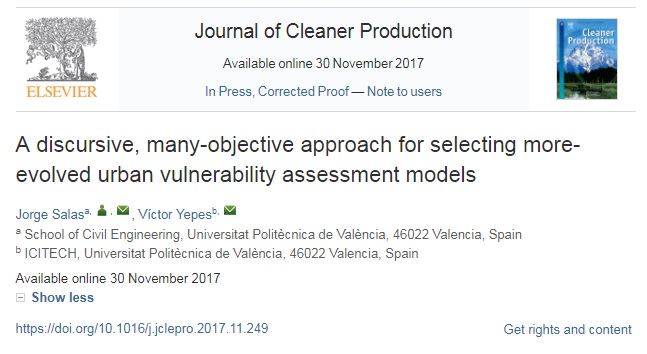 Acaban de publicarnos un artículo sobre evaluación de la vulnerabilidad urbana en la revista Journal of Cleaner Production, revista de fuerte impacto, pues se encuentra en el primer decil en el ámbito ENVIRONMENTAL SCIENCES de la Web of Science. Os dejo a continuación el resumen y el enlace al artículo por si os resulta de interés: http://www.sciencedirect.com/science/article/pii/S0959652617329232
Acaban de publicarnos un artículo sobre evaluación de la vulnerabilidad urbana en la revista Journal of Cleaner Production, revista de fuerte impacto, pues se encuentra en el primer decil en el ámbito ENVIRONMENTAL SCIENCES de la Web of Science. Os dejo a continuación el resumen y el enlace al artículo por si os resulta de interés: http://www.sciencedirect.com/science/article/pii/S0959652617329232
Os podéis descargar el artículo GRATUITAMENTE hasta el 1 de marzo de 2018 en esta dirección: https://authors.elsevier.com/c/1WMmc3QCo9NHfG
ABSTRACT:
The development of more-evolved urban vulnerability assessment (UVA) models has become an increasingly important issue for both policy agendas and academia. Several requirements have already been set for this goal; they should be pursued simultaneously. However, methods with such integration are yet to be developed. The present paper addresses this integration via a discursive process in which interactions between decision makers and the method contribute to the selection of a model fulfilling these requirements. That model yields a UVA built upon both qualitative information and quantitative data from indicators selected for the neighbourhood, city, province, region and country political administrative scales. The characteristics demanded are encoded both into the UVA assessment model and in the optimization and control modules governing the process. While the optimization produces compromise solutions, the control module supervises the process, provides dynamic control and enables the interactions. Interactions are informed with knowledge derived from the cognitive approach entailed by the method and afford a better understanding of the process dynamics. We conclude that the goodness of fit and time dynamics objectives are aligned. Therefore, UVA methods performing well for these objectives are available, although at the expense of a medium to poor performance in preferences and robustness.
KEYWORDS:
Urban vulnerability assessment; Discursive approach; Many-objective optimization; Cognitive approach
Reference:
SALAS, J.; YEPES, V. (2018). A discursive, many-objective approach for selecting more-evolved urban vulnerability assessment models. Journal of Cleaner Production, 176:1231-1244. https://doi.org/10.1016/j.jclepro.2017.11.249
 Nos acaban de publicar en la revista Sustainaibility (segundo cuartil en Web of Science) un artículo donde se explica una nueva metodología, VisualUVAM, que sirve de apoyo en la toma de decisiones relacionada con la vulnerabilidad urbana. Esta herramienta se ha aplicado a nivel regional, provincial y municipal en España. Complementa los artículos y estudios previos realizados por nuestro grupo de investigación en el marco del proyecto de investigación DIMALIFE, plasmados en la tesis doctoral de Jorge Salas, de la que ya comentamos algo en un artículo anterior.
Nos acaban de publicar en la revista Sustainaibility (segundo cuartil en Web of Science) un artículo donde se explica una nueva metodología, VisualUVAM, que sirve de apoyo en la toma de decisiones relacionada con la vulnerabilidad urbana. Esta herramienta se ha aplicado a nivel regional, provincial y municipal en España. Complementa los artículos y estudios previos realizados por nuestro grupo de investigación en el marco del proyecto de investigación DIMALIFE, plasmados en la tesis doctoral de Jorge Salas, de la que ya comentamos algo en un artículo anterior.
